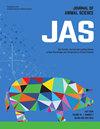Breed-specific heterosis for growth and carcass traits in 18 U.S. cattle breeds
IF 2.7
2区 农林科学
Q1 AGRICULTURE, DAIRY & ANIMAL SCIENCE
引用次数: 0
Abstract
Heterosis, or hybrid vigor, is traditionally defined as the advantage of crossbred progeny relative to the average performance of their purebred parents. This advantage is due to increased heterozygosity in these crosses, which increases phenotypic expression in traits influenced by non-additive gene action. These heterosis effects may vary depending on the breed of animals in the original cross; however, breed-specific estimates are difficult to obtain because of a lack of contemporary comparisons among crossbred and purebred cattle. The Germplasm Evaluation Program at the U.S. Meat Animal Research Center was designed to evaluate 18 of the most highly utilized beef breeds in the United States and enable contemporary comparisons among purebreds and their crosses. Therefore, the primary objective of this study was to quantify the differences in breed-specific heterosis for growth and carcass traits in these 18 U.S. beef breeds. Specific traits analyzed were direct and maternal birth weight, direct and maternal 205d adjusted weaning weight, 365d postweaning gain, marbling score, ribeye area, backfat thickness, and carcass weight. Specific heterosis effects were estimated using two different models: 1) a biological-group heterosis model where heterosis was estimated for crosses between British, Continental, and Brahman as breed groups, and 2) an average breed heterosis model where heterosis was estimated as the regression on average predicted breed heterozygosity arising from mating each of the 18 breeds to a randomly chosen animal in the population. Each model also included a random breed-specific cross effect for each pair of breeds. Biological-group heterosis, or the expected deviations from a purebred mean between all crosses of British-, Brahman-, and Continental-groups, was found for all traits (P < 0.0001), except marbling. The greatest increases in calf performance were estimated for crosses containing Brahman, especially for growth traits and maternal ability. Average breed-specific heterosis was also significant (P < 0.05) under the second model again for all traits except marbling and maternal birth weight. Again, the greatest increase in calf performance across a majority of traits was found to be the result of crosses with Brahman. These estimates may be used by breeders to make more informed crossbreeding decisions, and to tailor their choice of breeds to their specific production environment and breeding objectives.求助全文
约1分钟内获得全文
求助全文
来源期刊

Journal of animal science
农林科学-奶制品与动物科学
CiteScore
4.80
自引率
12.10%
发文量
1589
审稿时长
3 months
期刊介绍:
The Journal of Animal Science (JAS) is the premier journal for animal science and serves as the leading source of new knowledge and perspective in this area. JAS publishes more than 500 fully reviewed research articles, invited reviews, technical notes, and letters to the editor each year.
Articles published in JAS encompass a broad range of research topics in animal production and fundamental aspects of genetics, nutrition, physiology, and preparation and utilization of animal products. Articles typically report research with beef cattle, companion animals, goats, horses, pigs, and sheep; however, studies involving other farm animals, aquatic and wildlife species, and laboratory animal species that address fundamental questions related to livestock and companion animal biology will be considered for publication.
 求助内容:
求助内容: 应助结果提醒方式:
应助结果提醒方式:


